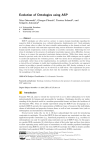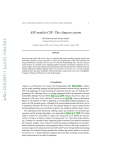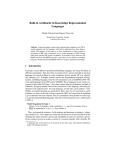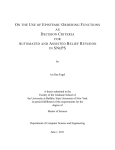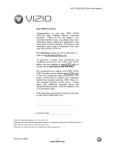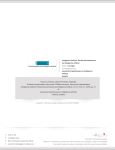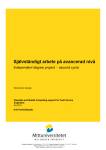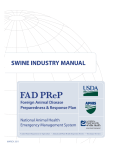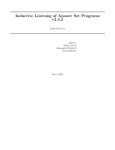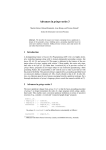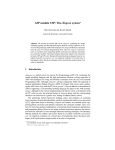Download Evolution of Ontologies using ASP
Transcript
1
FORTH Technical Report TR-415, May 2011
Evolution of Ontologies using ASP
Max Ostrowski1 and Giorgos Flouris2 and Torsten Schaub1 and Grigoris Antoniou2,3
1 Universität
Potsdam
2 FORTH-ICS
3 University
of Crete
Abstract
RDF/S ontologies are often used in e-science to express domain knowledge regarding the respective
field of investigation (e.g., cultural informatics, bioinformatics etc). Such ontologies need to change
often to reflect the latest scientific understanding on the domain at hand, and are usually associated
with constraints expressed using various declarative formalisms to express domain-specific requirements, such as cardinality or acyclicity constraints. Addressing the evolution of ontologies in the
presence of ontological constraints imposes extra difficulties, because it forces us to respect the associated constraints during evolution. While these issues were addressed in previous work, this is the
first work to examine how ASP techniques can be applied to model and implement the evolution process. ASP was chosen for its advantages in terms of a principled, rather than ad hoc implementation,
its modularity and flexibility, and for being a state-of-the-art technique to tackle hard combinatorial
problems. In particular, our approach consists in providing a general translation of the problem into
ASP, thereby reducing it to an instance of an ASP program that can be solved by an ASP solver.
Our experiments are promising, even for large ontologies, and also show that the scalability of the
approach depends on the morphology of the input.
1 Introduction
The Semantic Web’s vision, originally proposed in (Berners-Lee et al. 2001), is an extension of the current web that provides a common framework, including tools, languages and
methodologies, to allow information on the web to be both understandable by humans and
processable by machines; this enables people and machines to work in cooperation and
process meaning and information on the web. Ontologies describe our understanding of
the physical world in a machine processable format and form the backbone of the Semantic Web. They are usually represented using the RDF/S (McBride et al. 2004; Brickley and
Guha 2004) language; in a nutshell, RDF/S permits the representation of different types of
resources like individuals, classes of individuals and properties between them, as well as
basic taxonomic facts (such as subsumption and instantiation relationships).
Several recent works (Serfiotis et al. 2005; Motik et al. 2007; Lausen et al. 2008; Cali
et al. 2009; Tao et al. 2010) have acknowledged the need for introducing constraints in
ontologies. Given that RDF/S does not impose any constraints on data, any applicationspecific constraints (e.g., functional properties) or semantics (e.g., acyclicity in subsumptions) can only be captured using declarative formalisms for representing constraints on top
of RDF/S data. In this paper, we will consider DED constraints (Deutsch 2009), which form
a subset of first-order logic and have been shown to allow the representation of many useful types of constraints on ontologies; we will consider populated ontologies represented
using RDF/S, and use the term RDF/S knowledge base (KB) to denote possibly interlinked
2
Ostrowski et al.
and populated RDF/S ontologies with associated (DED) constraints. RDF/S KBs, being
representations of the real world, are often subject to change for various reasons, including
changes in the modeled world, new information on the domain, newly-gained access to information previously unknown or classified, and other eventualities (Umbrich et al. 2010;
Stojanovic et al. 2002; Flouris et al. 2008). Therefore, an important task towards the realization of the Semantic Web is the introduction of techniques that allow the efficient and
intuitive changing of ontologies in the presence of constraints. Given the constraints, one
should make sure that the evolution result is valid, i.e., it does not violate any constraints.
This is often called the Principle of Validity (Alchourron et al. 1985). In addition, the Principle of Success (Alchourron et al. 1985) should be satisfied, which states that the change
requirements take priority over existing information, i.e., the change must be applied in its
entirety. The final important requirement is the Principle of Minimal Change (Alchourron
et al. 1985), which states that, during a change, the modifications applied upon the original
KB must be minimal. In other words, given many different evolution results that satisfy the
principles of success and validity, one should return the one that is “closer” to the original
KB, where “closeness” is an application-specific notion.
The above non-trivial problem was studied in (Konstantinidis et al. 2008), resulting in a
general-purpose changing algorithm that satisfies the above requirements. Unfortunately,
the problem was proven to be exponential in nature, so the presented general-purpose algorithmic solution to the problem (which involved a recursive process) was inefficient.
ASP is a flexible and declarative approach to solve NP-hard problems. The solution that
was presented in (Konstantinidis et al. 2008) regarding the problem of ontology evolution
in the presence of integrity constraints can easily be translated into a logic program with
first-order variables; this is the standard formalism that is used by ASP, which is then
grounded into a variable free representation by a so called grounder that is then solved by
a highly efficient Boolean solver. As it is closely related to the SAT paradigm, knowledge
about different techniques for solving SAT problems are incorporated into the algorithms.
Using first-order logic programs is a smart way to represent the problem while remaining
highly flexible, especially in the set of constraints related to the ontology.
The objective of the present work is to recast the problem of ontology evolution in terms
of ASP rules, and use an efficient grounder and ASP solver to provide a modular and
flexible solution. In our work, we use gringo for the grounding and clasp for the solving
process as they are both state-of-the-art tools to tackle ASP problems (Gebser et al. ). Our
work is based on the approach presented in (Konstantinidis et al. 2008), and uses similar
ideas and notions. The main contribution of this work is the demonstration that ASP can
be used to solve the inherently difficult problem of ontology evolution in a decent amount
of time, even for large real-world ontologies. ASP was chosen for its advantages in terms
of a principled, rather than ad hoc implementation, its modularity and flexibility, and for
being a state-of-the-art technique to tackle hard combinatorial problems.
In the next section we describe the problem of ontology evolution and briefly present the
solution proposed in (Konstantinidis et al. 2008). In Section 3, we present ASP. Section 4
is the main section of this paper, where our formulation of the problem in terms of an ASP
program is presented and explained. This approach is refined and optimized in Section 5.
We present our experiments in Section 6 and conclude in Section 7.
Evolution of Ontologies using ASP
3
2 Problem Statement
2.1 RDF/S
The RDF/S (McBride et al. 2004; Brickley and Guha 2004) language uses triples of the
form (subject, predicate, object) to express knowledge. RDF/S permits the specification
of various entities (called resources), which may be classes (representing collections of resources), properties (which are binary relations between resources), and individuals (which
are resources). We use the symbol type(u) to denote the type of a resource u, stating
whether it is a class, a property, etc. RDF/S also allows for the description of various predefined relations between resources, like the domain and range of properties, subsumption
relationships between classes and between properties, and instantiation relationships between individuals and classes, or between pairs of individuals and properties. RDF/S KBs
are commonly represented as labeled graphs, whose nodes are resources and edges are relations (see Fig. 1 for an example). In that figure, a, b, and c are classes, whereas x is an
individual. Solid arrows represent subsumption relationships between classes (e.g., b is a
subclass of c), and dashed arrows represent instantiation relationships (e.g., x is an instance
of b). The bold arrow represents the change we want to make, namely to make a a subclass
of b.
2.2 Ontology Evolution Principles
As explained above, in the presence of constraints in the ontology, one
should make sure that the evolution result is valid, i.e., it does not violate
any constraints. This is often called the Principle of Validity (Alchourron
et al. 1985). Manually enforcing this principle is an error-prone and tec
dious process. The objective of this work is to assist knowledge engineers
in applying their changes in an automated manner, while making sure that
no invalidities are introduced in the KB during the evolution.
In addition to the Validity Principle, two other principles are usually
b
considered. The first is the Principle of Success (Alchourron et al. 1985),
stating that the required changes take priority over existing information,
i.e., the change must be applied in its entirety. The second is the Principle
x
of Minimal Change (Alchourron et al. 1985), stating that, during a change,
Fig. 1: A knowl- the modifications applied upon the original KB must be minimal. In other
edge base with words, given many different evolution results that satisfy the principles of
change (change
appearing as bold success and validity, one should return the one that is “closer” to the origarrow)
inal KB, where “closeness” is an application-specific notion. In this work,
we determine the notion of “closeness” that is used in the Principle of Minimal Change
using a relation; the function and use of this relation is described in detail later.
a
2.3 Formal Setting
To address the problem of ontology evolution, we use the general approach presented
in (Konstantinidis et al. 2008). In that work, an RDF/S KB K is modeled as a set of
ground facts of the form p(~x) where p is a predicate name and ~x is a vector of constants. Constants represent resources in RDF/S parlance, and for each type of relation-
4
Ostrowski et al.
RDF/S triple
Intuitive meaning
Predicate
c rdf :type rdfs:Class
x rdf :type rdfs:Resource
c1 rdfs:subClassOf c2
x rdf :type c
c is a class
x is an individual
IsA between classes
class instantiation
cs(c)
ci(x)
c IsA(c1 , c2 )
c Inst(x, c)
Table 1. Representation of RDF/S Triples Using Predicates
ID, Constraint
Intuitive Meaning
R5: ∀U, V c IsA(U, V ) → cs(U ) ∧ cs(V )
R12: ∀U, V, W
c IsA(U, V ) ∧ c IsA(V, W ) → c IsA(U, W )
R13: ∀U, V c IsA(U, V ) ∧ c IsA(V, U ) → ⊥
Class subsumption
Class IsA transitivity
Class IsA irreflexivity
Table 2. Ontological Constraints
ship that can appear in an RDF/S KB, a different predicate is defined. For example, the
triple (a, rdfs:subClassOf , b), which denotes that a is a subclass of b, is represented by the
ground fact c IsA(a, b). For the rest of the paper, predicates and constants will start with
a lower case letter, while variables will start with an upper case letter. Table 1 shows some
of the predicates we use and their intuitive meaning (see (Konstantinidis et al. 2008) for a
complete list).
We assume closed world, i.e., we infer that K 0 p(~x) whenever p(~x) ∈
/ K. A change C
is a request to add/remove some facts to/from the KB. For practical purposes, a change is
modeled as a set of (possibly negated) ground facts, where positive ground facts correspond
to additions, and negated ones correspond to deletions.
Ontological constraints are modeled using DED rules (Deutsch 2009), which allow
for formulating various useful constraints, such as primary and foreign key constraints
(used, e.g., in (Lausen et al. 2008)), acyclicity and transitivity constraints for properties (as
in (Serfiotis et al. 2005)), and cardinality constraints (used in (Motik et al. 2007)). Here,
we use the following simplified form of DEDs, which still includes the above constraint
types:
~
∀U
_
i=1,...,head
~i qi (U
~,V
~i ) ←e(U
~ ) ∧ p1 (U
~ ) ∧ · · · ∧ pbody (U
~ ),
∃V
~ ) is a conjunction of (in)equality atoms. We denote by p the facts
where e(U
~
~ ) and by q the facts q1 (U
~,V
~1 ), . . . , qhead (U
~,V
~head ). Table 2 shows
p1 (U ), . . . , pbody (U
some of the constraints used in this work; for a full list, refer to (Konstantinidis et al.
2008). We say that a KB K satisfies a constraint r (or a set of constraints R), iff K ` r
(K ` R). Given a set of constraints R, K is valid iff K ` R.
Now consider the KB K0 and the change of Fig. 1, which can be formally expressed
using the ground facts of Table 3. To satisfy the principle of success, we should add
K0
C
cs(a)
c IsA(b, c)
c Inst(x, b)
ci(x)
cs(b)
c IsA(b, a)
c Inst(x, c)
c IsA(a, b)
cs(c)
c IsA(c, a)
c Inst(x, a)
Table 3. Facts from example in Fig. 1
Evolution of Ontologies using ASP
5
c IsA(a, b) to K0 , getting K1 = K0 ∪ {c IsA(a, b)}. The result (K1 ) is called the raw
application of C upon K0 , and denoted by K1 = K0 + C.
C is called a valid change w.r.t. K0 iff K0 + C is valid. In our example, C is not a valid
change, because K1 violates rule R13; thus, it cannot be returned as an evolution result.
The only possible solution to this problem is to remove c IsA(b, a) from K1 (removing
c IsA(a, b) is not an option, because its addition is dictated by the change). This is an
extra modification, that is not part of the original change, but is, in a sense, enforced by it
and the related principles; such extra modifications are called side-effects. After applying
this side-effect, we would get K2 = K0 ∪ {c IsA(a, b)} \ {c IsA(b, a)}.
We note that K2 is no good either, because R12 is violated. To resolve this, we need to
apply more side-effects. In that case, we have two options, either removing c IsA(b, c) or
c IsA(c, a). This leads to two alternative solutions, namely K3.1 = K0 ∪ {c IsA(a, b)} \
{c IsA(b, a), c IsA(b, c)} and K3.2 = K0 ∪ {c IsA(a, b)} \ {c IsA(b, a), c IsA(c, a)}.
Again, adding c IsA(b, a) is not an option, because its addition was dictated in a previous
step.
Once again K3.1 , K3.2 are not valid, so one more step is required: for K3.1 , R12 is
/ K3.1 ), so we add
violated (because c IsA(c, a), c IsA(a, b) ∈ K3.1 but c IsA(c, b) ∈
c IsA(c, b) (the other options are overruled from previous steps) resulting to K4.1 ; for K3.2 ,
/ K3.2 ),
R12 is violated again (because c IsA(a, b), c IsA(b, c) ∈ K3.2 but c IsA(a, c) ∈
so we add c IsA(a, c) (the other options are overruled from previous steps) resulting to
K4.2 .
Now K4.1 , K4.2 are both possible results for the evolution, as they satisfy the principles
of success and validity. It remains to determine which of the two is “preferable”, in the
sense of the principle of minimal change, i.e., which of the two is “closer” to K0 .
As explained above, to determine this, we need to develop an ordering that
would “rank” K4.1 , K4.2 in terms of “closeness” to K0 . Note that K4.1 differs
from K0 in having added c IsA(a, b), c IsA(c, b) and deleted c IsA(b, a), c IsA(b, c),
whereas K4.2 differs from K0 in having added c IsA(a, b), c IsA(a, c) and deleted
c IsA(b, a), c IsA(c, a). We express this by using difference sets, called deltas, containing the ground facts that need to be added and the (negated) ground facts that need
to be deleted to get from one KB to another (denoted by ∆(K, K0 )). In our example,
∆(K0 , K4.1 ) = {c IsA(a, b), c IsA(c, b), ¬c IsA(b, a), ¬c IsA(b, c)}, ∆(K0 , K4.2 ) =
{c IsA(a, b), c IsA(a, c), ¬c IsA(b, a), ¬c IsA(c, a)}. Thus, the “ranking of closeness”
is essentially reduced to ranking ∆(K0 , K4.1 ), ∆(K0 , K4.2 ); note that both deltas have the
same size (and this occurs in many change scenarios), so ranking should be based on more
subtle differences, like the severity of changes in each delta, not just their cardinality.
In (Konstantinidis et al. 2008), a specific intuitive ordering is described (denoted by <K0 ,
where K0 the original KB). In a nutshell, the available predicates are ordered in terms of
severity using a special ordering, denoted by <pred ; for example, the addition of a class
(predicate cs) is more important than the addition of a subsumption (predicate c IsA), i.e.,
c IsA <pred cs. Then, a delta ∆1 is preferable than ∆2 (i.e., ∆1 <K0 ∆2 ) iff the most
important predicate (per <pred ) appears less times in ∆1 . In case of a tie, the next most
important predicate is considered and so on. If the two deltas contain an equal number of
ground facts per predicate (as in the case of our example with ∆(K0 , K4.1 ), ∆(K0 , K4.2 )),
the ordering considers the constants involved: a constant is considered more important if it
6
Ostrowski et al.
occupies a higher position in its corresponding subsumption hierarchy in the original KB.
In this respect, ∆(K0 , K4.1 ) causes less important changes upon K0 , than ∆(K0 , K4.2 ),
because the former affects b, c (c IsA(c, b), ¬c IsA(b, c)) whereas the latter affects c, a
(c IsA(a, c), ¬c IsA(c, a)); this means that K4.1 is a preferred result (over K4.2 ), per the
principle of minimal change. The ordering between ground facts that allows this kind of
comparison is denoted by <G . Formally: ∆(K0 , K4.1 ) <K0 ∆(K0 , K4.2 ); note that the
subscript K0 in the ordering is important, because the position of constants in the hierarchy
of the original KB (K0 ) is considered. For a more formal and detailed presentation of the
ordering, we refer the reader to (Konstantinidis et al. 2008).
We denote the evolution operation by •. In our example, we get K0 • C = K4.1 . Note
that K0 • C results from applying the change, C, and its most preferable side-effects upon
K0 .
3 Answer Set Programming (ASP)
In what follows, we rely on the input language of the ASP grounder gringo (Gebser et al. )
(extending the language of lparse (Syrjänen )) and introduce only informally the basics of
ASP. A comprehensive, formal introduction to ASP can be found in (Baral 2003).
We consider extended logic programs as introduced in (Simons et al. 2002). A rule r is
of the following form:
h ← b1 , . . . , bm , ∼bm+1 , . . . , ∼bn .
By head (r) = h and body(r) = {b1 , . . . , bm , ∼bm+1 , . . . , ∼bn }, we denote the head and
the body of r, respectively, where “∼” stands for default negation. The head H is an atom a
belonging to some alphabet A, the falsum ⊥, or a cardinality constraint L {`1 , . . . , `k } U .
In the latter, `i = ai or `i = ∼ai is a literal for ai ∈ A and 1 ≤ i ≤ k; L and U are
integers providing a lower and an upper bound. Such a constraint is true if the number of
its satisfied literals is between L and M . Either or both of L and U can be omitted, in which
case they are identified with the (trivial) bounds 0 and ∞, respectively. A rule r such that
head (r) = ⊥ is an integrity constraint; one with a cardinality constraint as head is called
a choice rule. Each body component Bi is either an atom or a cardinality constraint for
1 ≤ i ≤ n. If body(r) = ∅, r is called a fact, and we skip “←” when writing facts below.
In addition to rules, a logic program can contain #minimize statements of the form
#minimize[`1 = w1 @L1 , . . . , `k = wk @Lk ].
Besides literals `j and integer weights wj for 1 ≤ j ≤ k, a #minimize statement includes
integers Lj providing priority levels. A #minimize statement distinguishes optimal answer sets of a program as the ones yielding the smallest weighted sum for the true literals
among `1 , . . . , `k sharing the same (highest) level of priority L, while for L0 > L the sum
equals that of other answer sets. For a formal introduction, we refer the interested reader
to (Simons et al. 2002), where the definition of answer sets for logic programs containing extended constructs (cardinality constraints and minimize statements) under “choice
semantics” is defined.
Likewise, first-order representations, commonly used to encode problems in ASP, are
only informally introduced. In fact, gringo requires programs to be safe, that is, each vari-
Evolution of Ontologies using ASP
7
able must occur in a positive body literal. Formally, we only rely on the function ground
to denote the set of all ground instances, ground (Π), of a program Π containing first-order
variables. Further language constructs of interest, include conditional literals, like “a : b”,
the range and pooling operator “..” and “;” as well as standard arithmetic operations. The
“:” connective expands to the list of all instances of its left-hand side such that corresponding instances of literals on the right-hand side hold (Syrjänen ; Gebser et al. ). While “..”
allows for specifying integer intervals, “;” allows for pooling alternative terms to be used
as arguments within an atom. For instance, p(1..3) as well as p(1; 2; 3) stand for the three
facts p(1), p(2), and p(3). Given this, q(X) : p(X) results in q(1), q(2), q(3). See (Gebser
et al. ) for detailed descriptions of the input language of the grounder gringo.
4 Evolution using ASP
4.1 Potential Side-Effects
In order to determine the result of updating a KB, we need to determine the side-effects
that would resolve any possible validity problems caused by the change. The general idea
is simple: since the original KB is valid, a change causes a violation if it adds/removes a
fact that renders some constraint invalid. To explain this in more detail, let us denote by
∇ the set of potential side effects of a change C. In general, given a set of facts C, we will
write C + /C − to denote the positive/negative facts of C respectively. First of all, we note
that ∇ will contain all facts in C, except those already implied by K, i.e., if p(~x) ∈ C +
and p(~x) ∈
/ K, then p(~x) ∈ ∇+ , and if ¬p(~x) ∈ C − and p(~x) ∈ K then ¬p(~x) ∈ ∇−
(Condition I). The facts in the set ∇+ ∪ K are called available. This initial set of effects
may cause a constraint violation. Note that a constraint r is violated during a change iff
the right-hand-side (rhs) of r becomes true and the left-hand-side (lhs) is made false. Thus,
if a potential addition ∇+ makes the rhs of r true, and lhs is false, then we have to add
some fact from the lhs of the implication to the potential positive side-effects (to make lhs
true) (Condition II), or remove some fact from rhs (to make it false) (Condition III). If a
removal in ∇− makes the lhs of r false, and all other facts in rhs are available (so rhs is
true), we have to remove some fact from rhs (to make it false) (Condition IV). To do that,
we first define a select function si (X) = X \ {Xi } on a set X of atoms, to remove exactly
one element of a set. So we can then refer to the element Xi and the rest of the set si (X)
~ ) for pred (p1 , U
~ ), . . . , pred (pn , U
~ ), for
separately. Abusing notation, we write pred (p, U
~
~
any predicate name pred where p is the set of atoms p1 (U ), . . . , pbody (U ).
Formally, a set ∇ is a set of potential side-effects for a KB K and a change C, if the
following conditions are all true:
I x ∈ ∇ if x ∈ C + and x ∈
/ K or x ∈ C − and ¬x ∈ K,
~h qh (U
~,V
~h ) ∈ ∇+ if sl (p(U
~ )) ⊆ ∇+ ∪ K and pl (U
~ ) ∈ ∇+ and qh (U
~,V
~h ) ∈
II ∀V
/K
−
+
+
~
~
~
~
III ¬pj (U ) ∈ ∇ if sj (sl (p(U ))) ⊆ ∇ ∪ K and pl (U ) ∈ ∇ and pj (U ) ∈ K and for
~h either ¬qh (U
~,V
~h ) ∈ ∇− or qh (U
~,V
~h ) ∈
all V
/K
~ ) ∈ ∇− if sl (p(U
~ )) ⊆ ∇+ ∪ K and pl (U
~ ) ∈ K and ∀V
~h ¬qh (U
~,V
~h ) ∈ ∇− ,
IV ¬pl (U
~ wrt
for each constraint r defined in Section 2.3 and for all variable substitutions for U
~
E(U ) and for all 1 ≤ l, j ≤ body, l 6= j, 1 ≤ h ≤ head.
8
Ostrowski et al.
kb(cs, (a)).
kb(c IsA, (b, c)).
kb(c Inst, (x, b)).
kb(ci, (x)).
kb(cs, (b)).
kb(c IsA, (b, a)).
kb(c Inst, (x, c)).
changeAdd (c IsA, (a, b)).
kb(cs, (c)).
kb(c IsA, (c, a)).
kb(c Inst, (x, a)).
Table 4. Instance from example in Fig. 1
Our goal is to find a ⊂-minimal set of potential side-effects ∇, which means that there
exists no set of potential side-effects ∇0 such that ∇0 ⊂ ∇. We do this using the grounder
gringo, which ground-instantiates a logic program with variables. We create a logic program where the single solution is the subset minimal set of potential side-effects ∇.
To build a logic program, we first have to define the inputs to the problem, called instance. An instance I(K,C) of a KB K and a change C is defined as a set of facts:
I(K, C) = {kb(p, ~x) | p(~x) ∈ K}
∪ {changeAdd (p, ~x) | p(~x) ∈ C + }
∪ {changeDel (p, ~x) | p(~x) ∈ C − }.
In the above instance, predicate kb contains the facts in the KB, whereas predicates
changeAdd , changeDel contain the facts that the change dictates to add/delete respectively. Note that this representation forms a twist from the standard representation, since a
ground fact p(~x) ∈ K is represented as kb(p, ~x) (same for the change). The representation
of the KB K in Fig. 1 and its demanded change C can be found in Table 4.
Furthermore we have to collect all resources available in the KB (1) or newly introduced
by the change (2). So the predicate dom associates a resource to its type,
~
dom(type(Xi ), Xi ) ← kb(T, X).
(1)
~
dom(type(Xi ), Xi ) ← changeAdd (T, X).
(2)
~ The following two rules ((3) and (4)) correspond to Condition I above,
for all Xi ∈ X.
stating that the effects of C should be in ∇ (unless already in K). The predicates pAdd and
pDelete are used to represent potential side effects (additions and deletions respectively),
i.e., facts in the sets ∇+ , ∇− .
~ ← changeDel (T, X),
~ kb(T, X).
~
pDelete(T, X)
~ ← changeAdd (T, X),
~ ∼kb(T, X).
~
pAdd (T, X)
(3)
(4)
To find those facts that are added due to subsequent violations, we define, for the set ∇+ ∪
K, the predicate avail in (5) and (6). For negative potential side-effects ∇− we use a
redundant predicate nAvail (7).
~ ← kb(T, X).
~
avail (T, X)
~
~
avail (T, X) ← pAdd (T, X).
(5)
~ ← pDelete(T, X).
~
nAvail (T, X)
(7)
(6)
At a next step, we need to include the ontological constraints R into our ASP program,
by creating the corresponding ASP rules. Unlike ontological constraints which determine
whether there is an invalidity, we use the ASP rules to determine how to handle this invalidity. So now consider a constraint r ∈ R as defined in Section 2.3. For r, we define a set
Evolution of Ontologies using ASP
c IsA(a, b)
c IsA(b, b)
¬c IsA(b, a)
c IsA(c, c)
c IsA(a, a)
¬c IsA(b, c)
9
c IsA(c, b)
c IsA(a, c)
¬c IsA(c, a)
Table 5. Potential Side-effects of example in Fig. 1
of rules ((8)) that produce the set of potential side-effects according to Condition II.
~,V
~h )) ← e(U
~ ), avail (sl (p), U
~ ), pAdd (pl , U
~ ),
pAdd (qh , (U
~,V
~h )), dom(type(V
~h ), V
~h ).
∼kb(qh , (U
(8)
for all 1 ≤ l ≤ body and 1 ≤ h ≤ head. Similarly, to capture Condition III, we need two
sets of rules ((9) and (10)), since we do not want to do this only for negative side-effects
nAvail on the lhs of the rule, but also for facts that are not in the KB K,
~ ), avail (sj (sl (p)), U
~ ), pAdd (pl , U
~ ), kb(pj , U
~ ),
pDelete(pj , ~
u) ← e(U
~
~
~
~
nAvail (qh , (U , Vh )) : dom(type(Vh ), Vh ).
(9)
~ ) ← e(U
~ ), avail (sj (sl (p)), U
~ ), pAdd (pl , U
~ ), kb(pj , U
~ ),
pDelete(pj , U
~
~
~
~
∼kb(qh , (U , Vh )) : dom(type(Vh ), Vh ).
(10)
for all 1 ≤ l, j ≤ body, l 6= j, 1 ≤ h ≤ head. The last Condition IV can be expressed by
the following rule set (11)
~ ) ← e(U
~ ), avail (sl (p), U
~ ), kb(pl , U
~ ),
pDelete(pl , U
~
~
~h ), V
~h ).
pDelete(qh , U , Vh ) : dom(type(V
(11)
for all 1 ≤ l ≤ body and 1 ≤ h ≤ head.
Proposition 1
Given a KB K and a change C, and let A be the unique answer set of the stratified logic
program ground(I(K, C)∪{(1) . . . (11)}), then ∇ = {p(~x) | pAdd (p, ~x) ∈ A}∪{¬p(~x) |
pDelete(p, ~x) ∈ A} is a subset minimal set of potential side-effects of the KB K and the
change C.
For our example in Fig. 1, this results in the set of potential side-effects in Table 5. Note
that the potential side-effects contain all possible side-effects, including side-effects that
will eventually not appear in any valid change.
4.2 Solving the Problem
Note that the set of potential side-effects computed above contains all options for evolving
the KB. However, some of the potential changes in pAdd , pDelete are unnecessary; in
our running example, the preferred solution was {c IsA(a, b), ¬c IsA(b, a), ¬c IsA(b, c)}
(see Section 2), whereas Table 5 contains many more facts.
To compute the actual side-effects (which is a subset of the side-effects in pAdd ,
pDelete), we use a generate and test approach. In particular, we use the predicate
add (p, ~x) and delete(p0 , ~x0 ) to denote the set of side-effects p(~x) ∈ ∆(K, K0 ) (respectively ¬p0 (~x0 ) ∈ ∆(K, K0 )) and use choice rules to guess side-effects from pAdd , pDelete
to add , delete respectively (see (12), (13) below).
~ : pAdd (T, X)}.
~
{add (T, X)
~ : pDelete(T, X)}.
~
{delete(T, X)
(12)
(13)
10
Ostrowski et al.
Our changed KB is expressed using predicate kb 0 and is created in (14) and (15) consisting
of every entry from the original KB that was not deleted and every entry that was added.
~ ← kb(T, X),
~ ∼delete(T, X).
~
kb 0 (T, X)
0
~ ← add (T, X).
~
kb (T, X)
(14)
(15)
Moreover, we have to ensure that required positive (negative) changes C are (not) in the
new KB respectively (Principle of Success) ((16) and (17)).
~ ∼kb 0 (T, X).
~
← changeAdd (T, X),
0
~ kb (T, X).
~
← changeDel (T, X),
(16)
(17)
To ensure the Principle of Validity we construct all constraints from the DEDs R, using
the following transformation for each r ∈ R:
~ ), ∼1{kb 0 (qi , (U
~,V
~i ) : dom(type(V
~i ), V
~i ))}, e(U
~ ).
← kb 0 (p, U
(18)
for all 1 ≤ i ≤ head. Rule (18) ensures that if the rhs of a constraint is true wrt to the new
KB and the lhs if false, then the selected set of side-effects is no valid solution.
Proposition 2
Given a KB K, a change C and a set of potential side-effects ∇, we define a set of facts
∇0 = {pAdd (p, ~x) | p(~x) ∈ ∇} ∪ {pDelete(p, ~x) | ¬p(~x) ∈ ∇}. Let A be the answer set
of the logic program ground(I(K, C) ∪ ∇0 ∪ {(12) . . . (18)}), then ∆(K, K0 ) = {p(~x) |
add (p, ~x) ∈ A} ∪ {¬p(~x) | delete(p, ~x) ∈ A} is a valid change of KB K.
4.3 Finding the Optimal Solution
The solutions contained in add , delete are all valid solutions, per the above proposition,
but only one of them is optimal and should be returned, per the Principle of Minimal
Change. So, the solutions must be checked wrt to the ordering <K . For the most important
criteria <pred we generate minimize statements (see Section 3) that minimize the number
of occurrences of the applied side-effects. For adding classes, the corresponding minimize
statement looks as follows:
minimize[kb 0 (cs, X)@L :∼kb(cs, X)].
(19)
Here L denotes the level of the minimize constraint. So several minimize constraints can be
combined and the order of the minimize statements is respected. For the ordering <G , we
need to compare the distance of the entries (using their subsumption relation) to the top of
the hierarchy. Even though this distance can be computed using a grounder like gringo, for
simplicity we rely on a precomputed predicate lowestDist(type(X), X, N ) which gives
the distance N for each entry X. The corresponding minimization statement is:
minimize[kb 0 (cs, X) = −N @L0 : lowestDist(cs, X, N ) :∼kb(cs, X)].
(20)
Here −N denotes the weight of the literal in the statement. By using negative weights
we do maximization instead of minimizing. We clearly want to maximize the distance to
the top of the hierarchy. As these entities are less “general” and a change is therefore less
severe. Again, L0 = L − 1 denotes the level of the minimize constraint, so minimizing the
number of additions is more important than maximizing the distance.
As gringo allows hierarchical optimization statements, we can easily express the whole
ordering <K in a set of optimize statements O.
Evolution of Ontologies using ASP
11
Proposition 3
Given a KB K, a change C and a set of potential side-effects ∇, we define a set of facts ∇0 =
{pAdd (p, ~x) | p(~x) ∈ ∇} ∪ {pDelete(p, ~x) | ¬p(~x) ∈ ∇}. Let A be the answer set of the
logic program ground(I(K, C) ∪ ∇0 ∪ {(12) . . . (18)}), which is minimal wrt the optimize
statements O then ∆(K, K0 ) = {p(~x) | add (p, ~x) ∈ A} ∪ {¬p(~x) | delete(p, ~x) ∈ A} is
the unique valid minimal change of KB K.
5 Refinements
In this section, we refine the above direct translation, in order to increase the efficiency of
our logic program. Our first optimization attempts to reduce the size of the potential sideeffects ∇, whereas the second takes advantage of deterministic consequences of certain
side-effects to speed-up the process.
5.1 Incrementally Computing Side-Effects
As the set of potential side-effects directly corresponds to the search space for the problem
(see (12), (13) in Section 4), we could improve performance if a partial set of potential sideeffects that contains the minimal solution was found, instead of the full set. According to
the ordering of the solutions <pred , we use the symbol level(p) for each fact p(~x) to denote
the severeness of its application (per <pred ). We start with the least severe impact (level
1), incrementally assigning higher numbers for more severe changes. For example, adding
a class subsumption c IsA is on level 7 (level(c IsA) = 7), removing such a subsumption
has level(¬c IsA) = 15 and adding a class (cs) has level(cs) = 31. For a complete list of
such levels, see (Konstantinidis et al. 2008).
Per definition of the ordering, a set of side-effects that does not contain any fact p(~x)
with level(p) > k is “better” than a solution that uses at least one side-effect p0 (x~0 ) such
that level(p0 ) > k. Thus, we split the computation of the possible side-effects into different
parts, one for each level of <pred optimization. We start the computation of possible sideeffects with k = 1, only adding facts of level 1 to repair our KB. If with this subset of
possible side-effects no solution to the problem can be found, we increase k by one and
continue the computation, reusing the already computed part of the potential side-effects.
For grounding, this means we only want to have the possibility to find potential side-effects
p(~x) of a level(p) ≤ k. To exploit this idea, we associate each constraint r with a level,
denoted by level(r). The level of r is the maximum of the levels of the predicates qh , pj
that appear in the lhs of the corresponding ASP rules of r, namely (8) and (9), (10), (11)
respectively (see Section 4).
To express the corresponding ASP rules, we need some general rules. First, (21) stipulates the fact step for the current level; as we move to subsequent levels, step is updated to indicate the level we processed or are just processing. Rule (22) stipulates the fact
oldStep(l) for all already processed levels l.
step(k).
oldStep(k − 1) ← k > 1.
(21)
(22)
To denote potential side-effects of a given level k, we use the predicates newPadd (k, p, ~x)
and newPdel (k, p, ~x) (unlike pAdd , pDelete, which contain potential side-effects of all
12
Ostrowski et al.
levels). The ASP rules representing Condition I (originally expressed using (3) and (4) for
pAdd , pDelete) are expressed for the new predicates as follows:
~ ← changeDel (T, X),
~ k = 1, kb(T, X).
~
newPdel (k, T, X)
~ ← changeAdd (T, X),
~ k = 1, ∼kb(T, X).
~
newPadd (k, T, X)
(23)
(24)
The predicates pAdd and pDelete represent the potential side-effects already found in all
levels before k. Therefore the new additions from the last processed level are added to the
pAdd and pDelete predicate ((25) to (26)), respectively.
~ ← newPadd (k − 1, T, X).
~
pAdd (T, X)
~
~
pDelete(T, X) ← newPdel (k − 1, T, X).
(25)
(26)
The redundant predicates nNewAvail and newAvail contain everything that is newly available or not available at level k ((27) and (28)).
~ ← newPdel (k, T, X).
~
nNewAvail (k, T, X)
~ ← newPadd (k, T, X).
~
newAvail (k, T, X)
(27)
(28)
Finally, nAvail and avail “accumulate” the available/not available facts ((29) to (31)).
nAvail (T, ~
x) ← nNewAvail (k, T, ~x).
avail (T, ~
x) ← kb(T, ~
x).
avail (T, ~
x) ← newAvail (k, T, ~x).
(29)
(30)
(31)
For our conditions II, III and IV we can distinguish three different cases depending on
the level of the corresponding ASP rules. The ASP rules for constraints r with
• level(r) = k are grounded for all potential side-effects (new and old ones) and
entities in the KB.
• level(r) ≤ k, are only grounded if either of the potential side-effects on the rhs of
the rule r is newly added on the level k.
• level(r) < k are grounded if at least one of the potentially available/not available
entries has been added at step k.
These three steps are now described in detail for each condition. For Condition II, the
rule sets (32), (33), and (34) correspond to the set (8) (Section 4). The rule set (32) produces
the corresponding set of potential side-effects for the current incremental step k,
~,V
~h )) ← ∼pAdd (qh , (U
~,V
~h )), avail (sl (p), U
~ ), pAdd (pl , U
~ ),
newPadd (k, qh , (U
~ ), ∼kb(qh , (U
~,V
~h )), dom(type(V
~h ), V
~h ),
e(U
(32)
step(level(add, qh )), ∼step(level(add, qh ) + 1).
for all 1 ≤ l ≤ body, 1 ≤ h ≤ head. For constraints r with level(r) ≤ k, the following
rule (33) captures Condition II and checks whether one of the potential side-effects on the
rhs of the rule is newly added on the level k by using newPadd in the body of the rule. We
only add step(level(r)) to the rule to consider all levels,
~,V
~h )) ← ∼pAdd (qh , (U
~,V
~h )), avail (sl (p), U
~ ),
newPadd (k, qh , (U
~ ), e(U
~ ), ∼kb(qh , (U
~,V
~h )),
newPadd (k, pl , U
(33)
~h ), V
~h ), step(level(add, qh )).
dom(type(V
for all 1 ≤ l ≤ body, 1 ≤ h ≤ head. To capture Condition II for all constraints r with
level(r) < k, the rule (34) checks if at least one of the potentially available/not available
Evolution of Ontologies using ASP
13
entries has been added at step k. We add oldStep(level(r)) to the rules, to consider only
levels < k,
~,V
~h )) ← ∼pAdd (qh , (U
~,V
~h )), avail (sl (p), U
~ ), pAdd (pl , U
~ ),
newPadd (k, qh , (U
~ ), ∼kb(qh , (U
~,V
~h )), dom(type(V
~h ), ~vh ),
e(U
(34)
~ )}, oldStep(level(add, qh )).
1{newAvail (k, sl (p), U
for all 1 ≤ l ≤ body, 1 ≤ h ≤ head.
For Condition III, rules (35) to (40) correspond to the rules expressed in (9) and (10).
We use step(level(r)), ∼step(level(r) + 1) in the rule body, to denote that we only
want to consider the last (current) incremental step k in rules (35) and (36),
~ ) ← ∼pDelete(pj , U
~ ), avail (sj (sl (p)), U
~ ), pAdd (pl , U
~)
newPdel (k, pj , U
~ ), e(U
~ ), nAvail (qh , (U
~,V
~h )) : dom(type(V
~h ), V
~h ),
kb(pj , U
(35)
step(level(delete, pj )), ∼step(level(delete, pj ) + 1).
~
~ ), avail (sj (sl (p)), U
~ ), pAdd (pl , U
~ ),
newPdel (k, pj , U ) ← ∼pDelete(pj , U
~ ), e(U
~ ), ∼kb(qh , (U
~,V
~h )) : dom(type(V
~h ), V
~h ),
kb(pj , U
(36)
step(level(delete, pj )), ∼step(level(delete, pj ) + 1).
for all 1 ≤ l, j ≤ body, l 6= j, 1 ≤ h ≤ head. For constraints r with level(r) ≤ k,
the following rule set (37) and (38) capture Condition III and check whether one of the
potential side-effects on the rhs of the rule is newly added on level k
~ ) ← ∼pDelete(pj , U
~ ), avail (sj (sl (p)), U
~ ), newPadd (k, pl , U
~ ),
newPdel (k, pj , U
~
~
~
~
~
~
kb(pj , U ), e(U ), nAvail (qh , (U , Vh )) : dom(type(Vh ), Vh ),
(37)
step(level(delete, pj )).
~ ) ← ∼pDelete(pj , U
~ ), avail (sj (sl (p)), U
~ ), newPadd (k, pl , U
~ ),
newPdel (k, pj , U
~
~
~
~
~
~
kb(pj , U ), e(U ), ∼kb(qh , (U , Vh )) : dom(type(Vh ), Vh ),
(38)
step(level(delete, pj )).
for all 1 ≤ l, j ≤ body, l 6= j, 1 ≤ h ≤ head. The rule sets (39) and (40) check if at least
one of the potentially available/not available entries has been added at step k,
~ ) ← ∼pDelete(pj , U
~ ), avail (sj (sl (p)), U
~ ), pAdd (pl , U
~ ),
newPdel (k, pj , U
~ ), e(U
~ ), nAvail (qh , (U
~,V
~h )) : dom(type(V
~h ), V
~h ),
kb(pj , U
~ ),
1{newAvail (k, sj (sl (p)), U
~,V
~h )) : dom(type(V
~h ), V
~h )},
nNewAvail (k, qh , (U
oldStep(level(delete, pj )).
~
~ ), avail (sj (sl (p)), U
~ ), pAdd (pl , U
~ ),
newPdel (k, pj , U ) ← ∼pDelete(pj , U
~ ), e(U
~ ), ∼kb(qh , (U
~,V
~h )) : dom(type(V
~h ), V
~h ),
kb(pj , U
(39)
(40)
~ )}, oldStep(level(delete, pj )).
1{newAvail (k, sj (sl (p)), U
for all 1 ≤ l, j ≤ body, l 6= j, 1 ≤ h ≤ head.
Condition IV is captured using the rules (41) to (43) that correspond to the rules (11) in
Section 4. For the current incremental step k we use:
~ ) ← ∼pDelete(pl , U
~ ), e(U
~ ), avail (sl (p), U
~ ), kb(pl , U
~ ),
newPdel (k, pl , U
~,V
~h ) : dom(type(V
~h ), V
~h ),
pDelete(qh , U
(41)
step(level(delete, pl )), ∼step(level(delete, pl ) + 1).
for all 1 ≤ l ≤ body, 1 ≤ h ≤ head. For constraints r with level(r) ≤ k, the rule (42)
14
Ostrowski et al.
c IsA(a, b)
c IsA(b, b)
c IsA(c, c)
c IsA(a, a)
c IsA(c, b)
c IsA(a, c)
Table 6. Potential Side-effects of example in Fig. 1 to level 7
checks whether one of the potential side-effects on the rhs of r is newly added on level k,
~ ) ← ∼pDelete(pl , U
~ ), e(U
~ ), avail (sl (p), U
~ ), kb(pl , U
~ ),
newPdel (k, pl , U
~
~
~
~
newPdel (k, qh , U , Vh ) : dom(type(Vh ), Vh ),
(42)
step(level(delete, pl )).
for all 1 ≤ l ≤ body, 1 ≤ h ≤ head. To capture Condition IV for all constraints r with
level(r) < k, the rule (34) checks if at least one of the potentially available/not available
entries has been added at step k,
~ ) ← ∼pDelete(pl , U
~ ), e(U
~ ), avail (sl (p), U
~ ), kb(pl , U
~ ),
newPdel (k, pl , U
~
~
~
~
pDelete(qh , U , Vh ) : dom(type(Vh ), Vh ),
(43)
~ )}, oldStep(level(delete, pl )).
1{newAvail (k, sl (p), U
for all 1 ≤ l ≤ body, 1 ≤ h ≤ head.
We define the operator T (K, C, k), as T (K, C, 0) = ground(I(K, C)) and T (K, C, k)
where k > 0 is the set of facts of the unique answer set of the logic program
ground(T (K, C, k − 1) ∪ {(21), . . . , (43)}). T (K, C, n) produces a subset of the potential
side-effects only using repairs up to level n. Given our example in Fig. 1, T (K, C, 7) gives
us the set shown in Table 6 and T (K, C, 15) gives us the same set of side-effects as already
show in Table 5.
5.2 Exploiting Deterministic Side-Effects
A second way to improve performance is to consider deterministic side-effects of the original changes. As an example of a deterministic side-effect, suppose that the original change
includes the deletion of a class a (corresponding to the side-effect ¬cs(a)). Then, per
rule R5 (cf. Table 2), all class subsumptions that involve a must be deleted as well (corresponding to the side-effect ¬c IsA). Therefore, the latter side-effect(s) are a necessary
(deterministic) consequence of the former, so they can be added to the set of side-effects
right from the beginning (at level 1). Formally, for all DED constraints of the form
~
∀U
_
i=1,...,head
~i qi (U
~,V
~i ) ←e(U
~ ), p(U
~ ),
∃V
~ ) is a single atom, we generate the following rules:
where p(U
~,V
~j )) ← e(U
~ ), changeAdd (p, U
~ ),
changeAdd (qj , (U
~
~
~j ), V
~j ).
∼kb(qj , (U , Vj )), dom(type(V
~ ) ← e(U
~ ), kb(p, U
~ ),
changeDel (p, U
~,V
~j ) : dom(type(V
~j ), V
~j ).
changeDel (qj , U
(44)
(45)
for all 1 ≤ j ≤ head. In this way we extend our change by deterministic consequences, to
possibly reduce the number of incremental steps. For our example in Fig. 1 this results in
the additionally required changeDel (c IsA, (b, a)).
15
Evolution of Ontologies using ASP
n
1
2
3
4
5
6
times
123.3
243.7
454.6
619.0
711.1
756.1
level
2.37
4.72
8.50
11.94
13.44
14.27
timeouts
0
0
0
0
2
6
Table 7. (a) Go Benchmark
n
1
2
3
4
5
6
times
2.2
3.3
3.4
7.0
3.5
7.3
level
10.70
16.28
16.15
16.96
16.19
18.00
timeouts
0
20
30
51
66
76
(b) CIDOC Benchmark
6 Experiments
For our experiments, we considered two real-world ontologies of different size and structure in order to study the effects of both the size and of the morphology of the ontology on the performance of our approach. The first considered ontology is Gene Ontology
(GO (Consortium 2000)), a large ontology from the bio-informatics, consisting of roughly
458.000 entries (28.000 classes, 370.000 relations, and 60.000 instances). The second ontology is CIDOC (CIDOC 2010), a medium-sized ontology from the cultural domain, consisting of roughly 1500 entries (with about 250 properties, 80 classes and 700 relations).
As we can see, GO’s emphasis is on classes, while CIDOC contains many properties.
To generate the changes, we took the original knowledge base K (GO or CIDOC), randomly selected 6 entries I ⊆ K and deleted I from K, resulting in a valid KB K0 . We
then created our “pool of changes”, IC , which contains 6 randomly selected entries from
K0 (as deletions) and the 6 entries in I (as additions). The change C for our benchmark was
created by randomly selecting n entries from IC (1 ≤ n ≤ 6). Our experiment measured
the time required to apply C upon K0 . The above process was repeated 100 times for each
n (1 ≤ n ≤ 6), giving a total of 600 runs. The benchmark was run on a machine with
4 × 4 CPU’s, 3.4Ghz each and was restricted to 4 GB of RAM Our implementation uses a
single threaded version of gringo3.0.4 and clasp2.0.0RC1. A timeout of 3600 seconds was
imposed on the experiments, so that any run that reached this timeout was stopped.
Table 7 contains the results of our experiments in GO and CIDOC respectively. Each
row in the table contains the experiments for one value of n (size of C) and shows the
average CPU time (in seconds) of all runs that did not reach the timeout (column “times”),
the average level of incremental grounding where the solution was found (“level”) and the
number of timeouts (“timeouts”).
The results of our experiments are encouraging. GO, despite its large size and the inherently intractable nature of the evolution problem, can evolve in a decent amount of
time, and has very few timeouts. On the other hand, CIDOC exhibits a seemingly strange
behaviour: it has lots of timeouts, but very fast execution (on average) when no timeout
occurs. This indicates that the deviation of execution times, even for KBs/changes of the
same size, is very large for CIDOC, i.e., the performance is largely affected by the specific form of the KB or change. Given that this behaviour is much less apparent in GO,
we conclude that it is due to the existence of many properties in CIDOC; in fact, it turns
out that property-related constraints increase the number of potential side-effects, thereby
increasing the computational effort required, but only if such rules are violated. As a result,
for the updates that included many property-related changes the execution time increases,
often causing timeouts, whereas for updates that include few property-related changes the
16
Ostrowski et al.
execution time is rather small. Given that GO contains no properties, the execution times
are much more smooth (few timeouts, but worse average performance). If we concentrate
on the average level where a solution was found, we see a strong correlation between the
level and the average time reported. Also, we note that as the size of the change increases,
so does the level, and the average required time.
7 Summary and Outlook
In this paper, we studied how we can solve the problem of ontology evolution in the presence of ontological constraints, using ASP rules. Based on the setting and solution proposed in (Konstantinidis et al. 2008), we recast the problem and the corresponding algorithm in terms of ASP rules, thereby reducing the problem to an ASP program that can be
solved by an efficient and optimized ASP reasoner. This resulted to a flexible approach for
changing ontologies.
Given that the problem is inherently exponential in nature (Konstantinidis et al. 2008),
the reported times (Table 7) for the evolution of two real-world ontologies are decent.
To the best of our knowledge, there is no comparable approach, because the approach
presented in (Konstantinidis et al. 2008) did not report any experiments, and other similar
approaches either do not consider the full set of options (therefore returning a suboptimal
evolution result), or require user feedback to perform the change (which is not the case in
our implementation).
An interesting side-product of our approach is that the validity of an ontology can be
checked and/or imposed by simply applying the empty change upon it, so we plan to
explore this option in the future for repairing ontologies. In addition, we will consider
further optimizations that will improve the efficiency of the proposed modeling, such as
using incremental ASP solvers such as iclingo (Gebser et al. 2008). Finally, given that the
application of many small changes is usually faster than the application of a single large
one (because it leads to much smaller sets of potential side-effects), we plan to consider
methodologies for decomposing changes into smaller, independent sets that can be applied
in a sequence (rather than in a bulk manner), without jeopardizing the correctness and
optimality of the result.
References
A LCHOURRON , C. E., G ARDENFORS , P., AND M AKINSON , D. 1985. On the logic of theory
change: Partial meet contraction and revision functions. Journal of Symbolic Logic 50, 510–530.
BARAL , C. 2003. Knowledge Representation, Reasoning and Declarative Problem Solving. Cambridge University Press.
B ERNERS -L EE , T., H ENDLER , J. A., AND L ASSILA , O. 2001. The semantic web. Scientific American 284, 5, 34–43.
B RICKLEY, D. AND G UHA , R. 2004. Rdf vocabulary description language 1.0: Rdf schema. www.
w3.org/TR/2004/REC-rdf-schema-20040210.
C ALI , A., G OTTLOB , G., AND L UKASIEWICZ , T. 2009. Datalog±: A unified approach to ontologies
and integrity constraints. In Proceedings of the International Conference on Database Theory
(ICDT-09).
Evolution of Ontologies using ASP
17
CIDOC. 2010.
The CIDOC Conceptual Reference Model.
cidoc.ics.forth.gr/
official_release_cidoc.html.
C ONSORTIUM , T. G. O. 2000. Gene ontology: tool for the unification of biology. In Nature genetics.
Vol. 25. 25–29.
D EUTSCH , A. 2009. Fol modeling of integrity constraints (dependencies). Encyclopedia of Database
Systems, 1155–1161.
F LOURIS , G., M ANAKANATAS , D., KONDYLAKIS , H., P LEXOUSAKIS , D., AND A NTONIOU , G.
2008. Ontology change: Classification and survey. The Knowledge Engineering Review 23, 2,
117–152.
G EBSER , M., K AMINSKI , R., K AUFMANN , B., O STROWSKI , M., S CHAUB , T., AND T HIELE ,
S.
A user’s guide to gringo, clasp, clingo, and iclingo.
Available at
http://potassco.sourceforge.net.
G EBSER , M., K AMINSKI , R., K AUFMANN , B., O STROWSKI , M., S CHAUB , T., AND T HIELE , S.
2008. Engineering an incremental ASP solver. In Proceedings of the Twenty-fourth International
Conference on Logic Programming (ICLP’08), M. Garcia de la Banda and E. Pontelli, Eds. Lecture
Notes in Computer Science, vol. 5366. Springer Verlag, 190–205.
KONSTANTINIDIS , G., F LOURIS , G., A NTONIOU , G., AND C HRISTOPHIDES , V. 2008. A formal
approach for rdf/s ontology evolution. In Proceedings of the 18th European Conference on Artificial Intelligence (ECAI-08). 405–409.
L AUSEN , G., M EIER , M., AND S CHMIDT, M. 2008. Sparqling constraints for rdf. In Proceedings
of 11th International Conference on Extending Database Technology (EDBT-08). 499–509.
M C B RIDE , B., M ANOLA , F., AND M ILLER , E. 2004. Rdf primer. www.w3.org/TR/
rdf-primer.
M OTIK , B., H ORROCKS , I., AND S ATTLER , U. 2007. Bridging the gap between owl and relational
databases. In Proceedings of 17th International World Wide Web Conference (WWW-07). 807–
816.
S ERFIOTIS , G., KOFFINA , I., C HRISTOPHIDES , V., AND TANNEN , V. 2005. Containment and minimization of rdf/s query patterns. In Proceedings of the 4th International Semantic Web Conference
(ISWC-05).
S IMONS , P., N IEMEL Ä , I., AND S OININEN , T. 2002. Extending and implementing the stable model
semantics. Artificial Intelligence 138, 1-2, 181–234.
S TOJANOVIC , L., M AEDCHE , A., M OTIK , B., AND S TOJANOVIC , N. 2002. User-driven ontology
evolution management. In Proceedings of the 13th European Conference on Knowledge Engineering and Knowledge Management (EKAW-02).
S YRJ ÄNEN , T. Lparse 1.0 user’s manual. http://www.tcs.hut.fi/Software/smodels/lparse.ps.gz.
TAO , J., S IRIN , E., BAO , J., AND M C G UINNESS , D. 2010. Extending owl with integrity constraints.
In Proceedings of the 23rd International Workshop on Description Logics (DL-10). CEUR-WS
573.
U MBRICH , J., H AUSENBLAS , M., H OGAN , A., P OLLERES , A., AND D ECKER , S. 2010. Towards
dataset dynamics: Change frequency of linked open data sources. In Proceedings of the WWW2010
Workshop on Linked Data on the Web (LDOW2010).



















